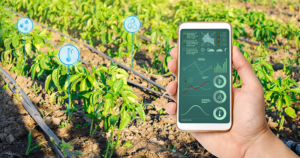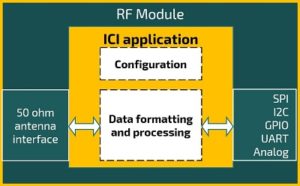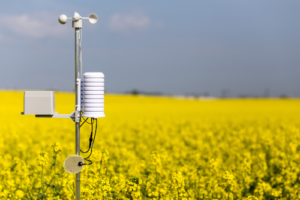Did you know that approximately 70% of the total volume of water withdrawals in the world are used for irrigation? And as you might guess, that is also where most water waste happens. Around 60% of the water meant to be used for irrigation is lost, either due to evapotranspiration, land runoff, or simply inefficient usage methods. The increasing scarcity of fresh water combined with the rampant growing global population calls for an immediate action to improve the way we collect, use, and store our already limited water supplies worldwide. This, in turn, brings to light, the importance of managing our global resources in a smarter and more efficient manner. There are many rising industries today which are designed with this requirement in mind which is being driven by the internet of things. Today, we will talk specifically about smart irrigation, which can go a long way in managing the rising levels of water stress worldwide.

Therefore, in this blog topic we will talk about what the drivers are in the smart irrigation market, what the specific problems to be solved in smart irrigation include, and finally, Radiocrafts Industrial IP Mesh solution, RIIM, which is a great solution for smart irrigation systems.
What are the Drivers in the Smart Irrigation Market?
The smart irrigation market is driven by the need to produce more eco-friendly systems and architectures to manage our resources as efficiently as possible and to reduce the environmental footprint. We also see a requirement to achieve this goal in a way which reduces the cost of creating such an infrastructure.
With smart irrigation it is possible to develop an irrigation system and produce food in places where previously it would be impossible, such as, a desert landscape. That is right! When you think of the word desert one of the first things that might come to mind is “barren”, “impossible to grow crops”, “no water”. However, with smart irrigation, we can transform such a landscape into a food producing paradise from where we can grow food for an ever-growing global population. This is also vital for producing more food locally in poor countries to feed its population, such as, around the Saharan region in Africa.

However, there are constraints in the smart irrigation market which include access to water, arable land, and labour to manage the irrigation system.
What are the Specific Problems to be Solved in Smart Irrigation?
There are several problems to be solved on the wireless communication end to have an efficient smart irrigation system. A few very important requirements include:
- Reliable connectivity (low packet loss, a typical good packet received number is 99,99%).
- Low latency (10ms is a good number for some applications where humans should not experience delays, other can tolerate a few seconds, typically in slow moving processes such as process monitoring, material flow, maintenance supervision.
- Sufficient range and coverage for a large semi open rural environment
- 2-way communication to not only collect data from sensors but also to control devices such as valves.
- Simple implementation, especially in locations like deserts which can be quite a harsh working environment.
- High reliability (long battery lifetime).
- Simple installation, no extra power cabling.
- OTA, many locations are hard to reach and will be in operation for a long time, so touch less updates of firmware is important.

Radiocrafts’ Industrial IP Mesh Solution as an Efficient Solution for Smart Irrigation Systems
RIIM by Radiocrafts is an Industrial IoT wireless IP mesh network completely embedded in a module. It includes all the critical components for a complete wireless IP mesh and has no license free or subscription costs. It is ready to go when you buy the module. Additionally, since RIIM is a mesh network, it is self-forming, self-healing and self-optimizing. This simplifies the installation and implementation of your smart irrigation system greatly.
RIIM can cover a huge area of around 80×80 km squared in a semi open rural environment. It also supports up to 1400 meters for each mesh hop (28 mesh hops maximum), and up to 1000 nodes for a single border router (gateway), reducing the cost of the installation as less gateways are needed to support a large scale deployment. To cover a larger area, you simply add another border router.
RIIM includes the ICI framework. An ICI application is always running on the module to tailor the modules behavior to the customers unique requirements. In its simplest form, the ICI application is just configuring the radio network, the modules hardware interfaces, and defines when to read and write to those interfaces. ICI makes it possible for the user to directly interface to virtually any sensor and/or actuator, such as a soil moisture sensors, water valve control, UV sensors, rain/freeze sensors, wind sensors, and more, removing the need for external circuitry. It supports mist computing to reduce bandwidth requirements and for fast responses to local events.

RIIM also supports faulty node detection where the Border Router sends a message to every node asking if they are still connected to the network. If the Border Router does not receive a reply from one of the nodes, this means that this node is lost. This makes maintenance of the network a lot easier.
A RIIM network supports 2-way symmetrical communication which is essential for valve control. This is an important point as many other IoT connectivity solutions have been designed with one-way sensor data communication in mind. Smart irrigation systems do not only need to collect sensor readings, they typically also need to control devices such as valves. Valve control is an example of down-link communication, something many popular LPWAN (Low Power Wide Area Networking) technologies struggle to support in a scalable manner. RIIM, on the other hand, was designed from the beginning to support this in a scalable manner. Because RIIM handles down-link communication as good as up-link communication, we say that it is a fully symmetric solution.

Another benefit of a fully symmetric communication is that it can support Over-The-Air Updates. This means that the user can update the user defined ICI firmware when the network is deployed and in full operation, so new sensors/controllers can be added when the need arises. With Smart Irrigation Systems, often times, many locations are hard to reach and will be in operation for a long time, so touch less updates of firmware are important.
RIIM is an exceptionally reliable solution that supports Time Synchronized Channel Hopping (TSCH) which was designed to make a mesh with less packet collision and higher reliability. A TSCH network has proven to have a reliability of up to 99.99%. RIIM is also protected by encryption using a pre-shared key and supports DTLS end to end security making your smart irrigation system hacker free!

RIIM is very low power for battery operation supporting long lasting projects. It supports several features that reduce power consumption, including:
- The chosen electronic components inside are low power to start with.
- The network leaf nodes can be put in “Sleepy” mode, reducing the current consumption to a minimum (4.7 uA).
- The output power of the module is configurable, not to consume more power than needed during transmit.
- The TSCH, Time Synchronized Channel hopping, allows for the Mesh routers to go to sleep when there is no time slot for incoming or outgoing RF data packages.
- The data processing that can be done by the customer in ICI can save substantial power. RIIM™ supports cloud computing which means that instead of sending all raw sensor reading data to the Cloud, the user can just send the interesting data, such as an alarm when a threshold is met.
A RIIM node can last 10 years on a CR2772 (870 mAh capacity coin cell battery) while sending 12 bytes every hour, 24 hours per day.
What to Take Away From This?
The global population is growing at faster rate than ever before, yet our global resources are becoming more and more scarce as times goes by, especially our natural water sources. This combination of facts creates an undying need for humans to use the limited resources we already have as efficiently as possible. The Internet of Things, while still a new concept, has made insurmountable strides in achieving this goal. One of many ways the IoT industry has helped maximise efficiency while being more eco-friendly is in Smart Irrigation. There are many requirements to create a truly effective smart irrigation system such as the need for an RF module with long range, great coverage, 2-way communication, low power, and more. All these requirements and more are covered by Radiocrafts Industrial IP Mesh solution which proves to be a great solution for Smart Irrigation.


